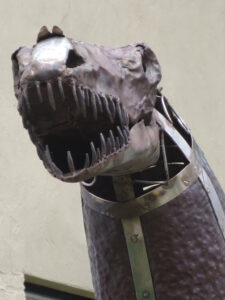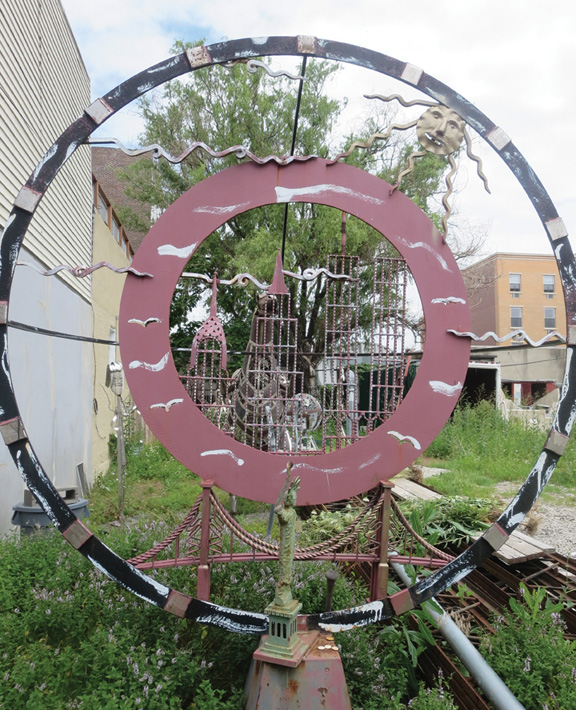Tony walks with a gait that is unique in this neck of the woods. No slouching stroll to buy a slab of Blueberry Buckle at Baked. Even though his property is next door and even if he has fifty feet to cover between there and his sculpture garden named the ‘Golden Anvil’ – he hurries. In September Antonio Cuonzo will open his Italian Sculpture Garden with an entrance on Dikeman right behind 361 Van Brunt.

Tony was 18 when he came over from the little ancient stone compound of Palo de Colle just outside the Apulian city of Bari and he had no time for cards.
“You don’t look Italian.” I brazenly noted during our interview, “Are you really, I mean really Italian Italian?” He is fair, white haired, blue eyes, sharp nose, and that wonderful purposeful chin. “Well, you know, Italians can be fair,” he noted.
“My town goes back further than the Greeks” Tony said. “But we still have named streets for them anyway.” This too is true. Southern Italy was restive, overrun, overruled, ransacked and helpless against the Greeks, the French, the Spanish even the Moors, for years and years.
Tony, one of seven childre, needed to work from the time he was 16. His family lived in a three storied stone house with a water cistern in the basement called, “la piscina’ to collect the rain water. It was ancient and an ancient idea, and not just a simple hole dug in the ground like we might do here in Red Hook, today, but a small architectural masterpiece of arched vaulting and masonry lined receptacles.
The ground floor was rented out to a clothing store and the second floor was his mother’s kitchen, “Old fashioned with enormous cauldrons and wood burning under them. We ate orecchete with broccoli rabe. Meat was expensive so we had mostly vegetables, lots of them brought to my father, who was the blacksmith. They offered this to make him charge them less or to settle bills.” He lived to be 94.”
And Dad ruled. He sent his older son Gaetano to Venezuela for black-smithing when that country opened its doors to Italian immigrants. He apprenticed Tony to a truck mechanic in Bari. Two years later, Tony emigrated.
“If you wanted to come over, you had to be vouched for. You had to prove that there was either a job waiting or that someone would support you. You needed the papers to prove it. That’s why we all went to live with my sister in Bensonhurst. She had married an Italian American and for five thousand dollars they built them a big house.”
The weekend before Tony arrived his brother hustled a job for him on Van Brunt Street. He worked at a German owned diesel mechanic shop. This was over fifty years ago.
I had to interrupt again. It’s a bad habit in general but pretty good if you want to squeeze the last drop of memory out of your subject. I needed to know why he made the fifty enormous welded bigger than life statues, some of them sitting behind Botta Di Vino, Baked and Gallery Small New York. You can peer through the painted railing on Dikeman Street and see the twenty foot dinosaur and the emblematic skyline of New York forged out of steel and copper.
“I never think of myself as an artist but I couldn’t help myself. I get pulled to it.”

“I forged the first pieces maybe fifteen twenty years ago in my Ironsmith shop on 20th Street and Third Avenue. First a sombrero shaped metal table with a wood top. I loved to watch the kids come by and look at them. That made me feel good. Then the inspectors ‘come by and tell me’ I can’t do it. It’s a fire hazard. So I move everything to my big barn in Bloomfied just outside Oneonta. Then I realize, ‘Tony, you an idiot. Who can see it here. All the trucks zip by, the farmers don’t care. And that’s why it’s here.”
Tony is a man on a mission. A widower, he moves like the diesel trucks he first fixed on Van Brunt, purposefully and straight ahead. Some of his work is in stainless steel and iron and requires protection from the elements.
He has meticulously forged a seamless six foot statue of the Saint which stands behind Botta di Vino as we speak. I wanted to know why he sculpted the modern saint, a Neopolitan himself, born in nearby Pietrelcina in 1887. A Capuchin monk clearly modeling himself after Saint Francis including the stigmata, Pio spent most of his time healing and soothing the Apulians in and around Bari.
“I don’t believe in that stuff about miracles and superstitions.” Then Tony told me this story. First he asked me not to tell too much about him, he’s a private and very circumspect man. I hope I have honored that to some extent. Fame for him is having a child briefly enjoy his work. Actually, fame is not on his to do list.
He and his wife Rosemarie lived for fifty years in the same house in Brooklyn. They worked together, up every morning at 7 and to the Iron shop by 7:30. She kept the books. One day she asked Tony to turn on the lights.
“But the lights were all on.” He took her to every specialist he could. Work suffered and he didn’t care.
She became despondent, “Tony, could you live this way?” she asked.
One fancy doctor in Manhattan said to her face, “If I can’t cure my own brother of blindness what makes you think I can do it for you?” Imagine, he said, a doctor saying that to her face?
A friend of his told him that someone’s son in the welding business a few years back had tossed some acid in the garbage and sustained injures from the explosion. He had lost his vision and his hearing. They took him all the way back to Foggia and the mountain top retreat where Padre Pio lived to have the holy man lay his hands on the teen’s head, “You will see again.” Upon their egress out of the sanctuary, the young man began to sense light. Little by little even his hearing came back.
Tony never believed in this. He was, after all, American by now. Then a friend told him there was a new shrine to the recently deceased Padre Pio in of all places Barto, Pennsylvania. Off they went, to a reliquary of Pio’s glove – nee Francesco – encased in glass. You pay some money and kiss the glass. They swoop down, Windex it off and up comes another supplicant.
“When I get back and walk in the door the phone is ringing. I don’t want to pick it up. I’m tired. ‘No, pick it up it could be one of the kids,’ she says.” So he picked it up. It was a friend with yet another recommendation for another expert doctor in Manhattan. ‘Why bother?’ he thought. But his wife newly hopeful became insistent. When they finally went it was stacked high with all the x-rays and comments of previous geniuses.
“What’s all that?”
“What other doctors say,” Tony answered.
“I do my own work. Let’s take a look.”
Then after tests, “A little spot here.” A small blood flow anomaly. Tiny. He fixed it.
One day not long after the operation on the one eye that could be saved, she saw light at her son’s house over Easter Dinner. She waited several hours to tell Tony because she couldn’t believe it for certain. Then little by little day following day, her sight pushed back.
“So that’s why you made the statue. Because you believe in him now?”
“No, Sandy, I still don’t. But the coincidence, ya know, the coincidence….” His face was remembering, there’s no telling how his heart was feeling.
Come September, you too can visit Padre Pio, The Dinosaur, Faces, the Manhattan skyline and his personal favorite. An enormous twenty foot twisted stainless knot with a face atop. It took him three tries to get the sculpture right.
“You think it’s easy twisting stainless steel?” That’s all he really needed to say about his work of art. And it’s enough. 








